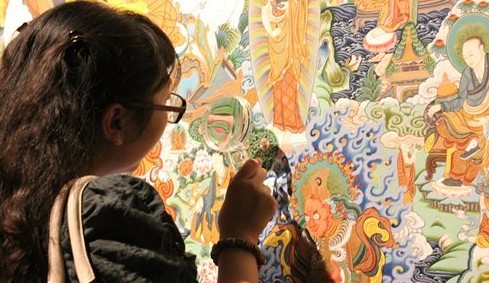 Air Forces arrive at designated area to join China-Russia drill
Air Forces arrive at designated area to join China-Russia drill
 Heat wave expected to break in mid-August
Heat wave expected to break in mid-August
 Old town Dali hosts int'l photography exhibition
Old town Dali hosts int'l photography exhibition
 A brighter future for Sino-Russian relations
A brighter future for Sino-Russian relations
 New police weapon to tackle armed suspects
New police weapon to tackle armed suspects
 Nutrica recalls Karicare infant formula in New Zealand
Nutrica recalls Karicare infant formula in New Zealand
 Sexy models in CFGP race
Sexy models in CFGP race
 Child labor still remains rampant in war-hit Afghanistan
Child labor still remains rampant in war-hit Afghanistan
 Sun Yang the star of last day at World Swimming Championships
Sun Yang the star of last day at World Swimming Championships
 |
| (GT/ Li Jingjing) |
Tibetan Buddhism is a distinct and prosperous offshoot of the Buddhist religion. It profoundly impacted the unique culture of the Tibetan Plateau. To people who are interested in understanding the religious culture of this region, an introduction to Thangka is a must. This painting style is the most representative art of Tibetan Buddhism.
People in Beijing got a chance to get close to this culture and receive a visual feast this week. An exhibition of works by Thangka art masters from Qinghai Regong was held at Beijing Himalaya Art Gallery in the 798 art district on August 4.
This exhibition brought together Thangka paintings that represent the highest level of art from Regong. The works came from national-level masters of arts and crafts, Niangben, Douga, Xihedao and Gengdengdaji, and representative inheritors of the intangible cultural heritage - the Regong Art, Luozangdanba, Emacaidan and Xiawujiao.
About 40 Thangka paintings that cover various styles including colorful ones and golden ones were presented in this exhibition. Among them were the 4.3-meter-long The 8 Forms of Padmasambhava painted by Niangben, and the 2.3-meter-long Sakyamuni Buddha and Eighteen Arhats painted by Douga.
Seven Thangka masters came all the way from Huangnanzhou, Qinghai Province, to 798 art district in Beijing, bringing the most representative visual arts of Tibetan Buddhism to this landmark of Chinese contemporary art.
Besides the paintings, the atmosphere in the Himalaya Art Gallery also left a unique impression those who attended. The fist digital mandala was presented during the exhibition, and it displayed the process of a lotus first blooming and eventually dying away. With Buddhist music played live by Ma Changsheng, a guqin (seven-string Chinese zither) performer and Buddhist music artist, attendees were bathed in a Zen-like atmosphere.
The exhibitions of traditional and religious culture were injected with new vitality. The curator from Himalaya, Wang Xiang, used lighting effects, voice-over and background music - methods usually reserved for stage performances - to present the exhibition.
The gallery also provided iPads, headsets, and magnifying glasses for visitors. People at the exhibition used the Himalaya's smart phone app to read detailed information about the Thangka paintings and painters as they stood appreciating the works. These new media methods brought more than an exhibition to visitors: It was also a form of spiritual meditation.
Wang said, "Thangka isn't the only thing that we want to present. We are trying to bring Tibetan Buddhism to more people through this. And we hope people can experience the religious atmosphere and relax a bit here."
 Chinese troops of "Peace Mission - 2013" arrive at exercise area
Chinese troops of "Peace Mission - 2013" arrive at exercise area Pakistan's rain-triggered accidents claim 29 lives: media
Pakistan's rain-triggered accidents claim 29 lives: media Daily life of auctioneer in Beijing
Daily life of auctioneer in Beijing Top 10 most dangerous jobs in the world
Top 10 most dangerous jobs in the world Zhang Ziyi graces Femina magazine
Zhang Ziyi graces Femina magazine Breathtaking images of extreme sports
Breathtaking images of extreme sportsDay|Week|Month